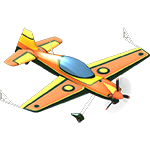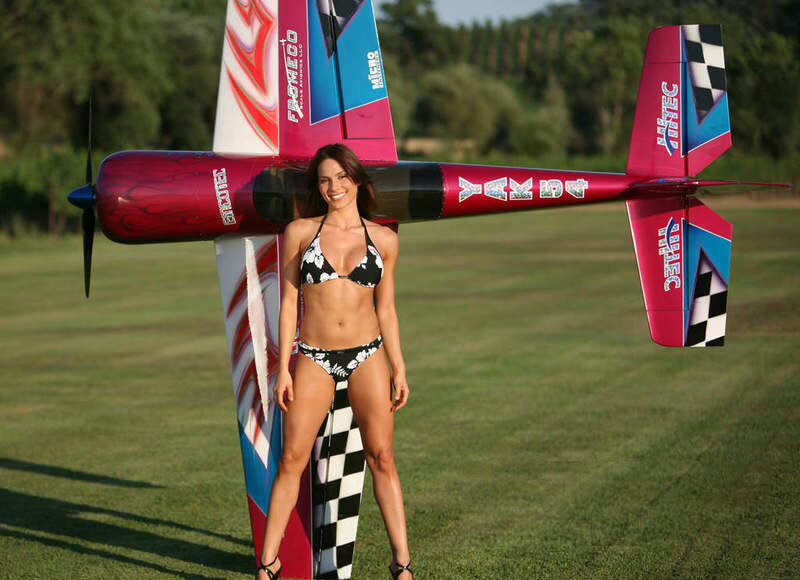The RC Planes Everyone Will Be Talking About This Year
Smoother flying. Smarter features. Affordable options that don’t skimp on style. This year’s planes are built to inspire—and they’ll make you fall in love with RC all over again.
The RC aviation landscape in 2025 has reached unprecedented heights, with manufacturers delivering technology and value that would’ve seemed impossible just years ago. Whether you’re upgrading your hangar or taking your first flight, choosing the right aircraft separates frustration from pure flying joy. Today’s best RC planes combine cutting-edge electronics with proven designs, creating experiences that rival full-scale aviation.
This comprehensive roundup spotlights the definitive champions across ten categories—planes that genuinely excel where it matters. From the virtually uncrashable E-flite Apprentice STS with revolutionary SAFE technology to the budget-crushing VOLANTEXRC TrainStar Ascent, these aircraft represent the pinnacle of current offerings.
What sets 2025’s lineup apart is the democratization of advanced features. Smart telemetry, GPS-assisted landing, and gyro stabilization have trickled down to entry-level models, while premium offerings pack capabilities rivaling full-scale systems. You’re getting more plane per dollar than ever, with reliability that keeps you flying instead of fixing.
Best RC Planes Compared at a Glance
Finding the perfect RC plane means weighing multiple factors against your specific needs. This comparison chart rates our top 10 picks across critical criteria using a 5-star system.
| RC Plane Model | Skill Level | Aircraft Type | Power System | Build Type | Durability | Wingspan | Channels | Flight Time | Parts & Support | Budget |
|---|---|---|---|---|---|---|---|---|---|---|
| E-flite Apprentice STS 1.5m | ★★★★★ | ★★★★★ | ★★★★ | ★★★★ | ★★★★ | ★★★★★ | ★★★★ | ★★★★ | ★★★★★ | ★★★ |
| VOLANTEXRC TrainStar Ascent | ★★★★ | ★★★★ | ★★★★ | ★★★ | ★★★★★ | ★★★★★ | ★★★★ | ★★★★ | ★★★ | ★★★★★ |
| HobbyZone Carbon Cub S2 | ★★★★★ | ★★★★ | ★★★★ | ★★★★★ | ★★★★ | ★★★★ | ★★★★ | ★★★ | ★★★★★ | ★★★★ |
| VOLANTEXRC F4U Corsair | ★★★★★ | ★★★ | ★★★ | ★★★★★ | ★★★★ | ★★ | ★★★★ | ★★★★ | ★★★ | ★★★★★ |
| E-flite P-51D Mustang | ★★ | ★★★★★ | ★★★★★ | ★★★ | ★★★ | ★★★★ | ★★★★★ | ★★ | ★★★★★ | ★★ |
| E-flite Turbo Timber Evolution | ★★★ | ★★★★★ | ★★★★★ | ★★★ | ★★★★★ | ★★★★★ | ★★★★★ | ★★★★ | ★★★★★ | ★★★ |
| FMS Extra 300 V2 | ★★ | ★★★★★ | ★★★★ | ★★★ | ★★★ | ★★★ | ★★★★ | ★★★ | ★★★★ | ★★★★ |
| PowerUp 4.0 RC Paper | ★★★★★ | ★★ | ★★ | ★★★★★ | ★★★ | ★ | ★★ | ★★★ | ★★★ | ★★★★★ |
| T28 Trojan 4CH | ★★★★★ | ★★★ | ★★★ | ★★★★★ | ★★★★★ | ★★ | ★★★★ | ★★★★ | ★★★ | ★★★★★ |
| GoolRC F949 Cessna | ★★★★★ | ★★★ | ★★ | ★★★★★ | ★★★★ | ★★ | ★★★ | ★★★★★ | ★★ | ★★★★★ |
Best RC Planes – a Quick Overview
E-flite Apprentice STS 1.5m – Best Overall
The gold standard trainer builds on E-flite’s legendary platform with cutting-edge SAFE technology and Smart electronics. This 59-inch wingspan beauty serves as the official AMA trainer for good reason.
- Key Features: Three-mode SAFE with panic recovery, telemetry-capable Smart ESC, optional GPS AutoLand, tricycle landing gear.
- Pros: Nearly uncrashable in beginner mode; grows with skills; extensive parts availability.
- Cons: Requires separate battery/charger; large transport size.
- Ideal User: First-time pilots, club training programs, instructors.
- Price Range: $330 RTF Basic (add $60-70 for battery/charger).
VOLANTEXRC TrainStar Ascent – Best Value
This 55-inch plastic-fuselaged trainer delivers big-plane stability at bargain prices. Unibody ABS construction survives crashes that would total foam planes.
- Key Features: Crack-resistant ABS fuselage, click-plug wings, 1050KV brushless motor, glider-like characteristics.
- Pros: Incredibly durable; excellent slow-flight; powerful motor.
- Cons: No gyro stabilization; slightly heavier than foam.
- Ideal User: Budget-conscious beginners wanting durability.
- Price Range: $180 PNP, $250 RTF.
HobbyZone Carbon Cub S 2 – Best Budget-Friendly
This scale Cub packs SAFE technology, telemetry, and genuine bush-plane capability into a $300 package.
- Key Features: SAFE with GPS upgrade path, oversized tundra tires, telemetry-ready ESC, scale appearance.
- Pros: Versatile terrain capability; upgradeable; excellent support.
- Cons: Battery sold separately; taildragger requires finesse.
- Ideal User: Beginners who appreciate scale realism with growth potential.
- Price Range: $300 RTF Basic.
VOLANTEXRC F4U Corsair – Best for Beginners
This 400mm warbird delivers authentic WWII fighter looks with docile, gyro-stabilized flight.
- Key Features: 6-axis Xpilot stabilization, one-key aerobatics, prop-saver, 15-minute flights.
- Pros: Warbird thrills without difficulty; crash-resistant; complete RTF.
- Cons: Limited to calm conditions; basic transmitter.
- Ideal User: Newcomers wanting cooler alternatives to trainers.
- Price Range: $120 RTF complete.
E-flite P-51D Mustang 1.2m – Best Warbird
Museum-quality Mustang with working flaps, electric retracts, and iconic four-blade prop. AS3X stabilization keeps it manageable.
- Key Features: Functional flaps/retracts, 3S/4S compatible, AS3X with SAFE Select option, authentic scheme.
- Pros: Stunning scale detail; wide performance envelope; docile handling.
- Cons: Intermediate skills required; shorter 4S flight times.
- Ideal User: Warbird enthusiasts stepping up from trainers.
- Price Range: $380 BNF Basic.
E-flite Turbo Timber Evolution 1.5m – Best STOL Performer
The ultimate bush plane takes off in three feet and practically hovers in headwinds. Evolution adds thrust reversing and included floats.
- Key Features: Functional flaps/slats, 70A Smart ESC with reverse, floats included, LED lighting.
- Pros: Unmatched STOL performance; incredibly versatile; bombproof construction.
- Cons: Large wingspan; complexity for beginners.
- Ideal User: Adventure seekers flying from anywhere—fields, water, parking lots.
- Price Range: $330 BNF Basic.
FMS Extra 300 V2 1100mm – Best for Precision Flying
This 43-inch aerobatic thoroughbred delivers pattern-quality precision at fraction of competition costs.
- Key Features: 3D-capable power, removable wings, optional Reflex stabilization, neutral characteristics.
- Pros: Exceptional precision; wide envelope; great aerobatic value.
- Cons: Zero inherent stability; demands skilled piloting.
- Ideal User: Intermediate-advanced pilots mastering aerobatics.
- Price Range: $220 PNP.
PowerUp 4.0 RC Paper – Best DIY Kit
Transform paper airplanes into smartphone-controlled aircraft with this ingenious module featuring onboard autopilot.
- Key Features: Bluetooth control, automatic stabilization, 10-minute flights, custom designs.
- Pros: Encourages experimentation; educational; capable autopilot.
- Cons: Limited range (230 feet); weather-dependent.
- Ideal User: Kids, educators, creative tinkerers.
- Price Range: $70 kit.
T28 Trojan 4-Channel – Most Durable
EPP foam warbird that’s virtually indestructible. Xpilot stabilization and prop-saver mean crashes rarely ground this fighter.
- Key Features: Flexible EPP construction, prop-saver, 3-mode gyro, 15-20 minute flights.
- Pros: Absorbs crashes; long flights; warbird looks with trainer manners. Cons: Basic transmitter; light wind limits.
- Ideal User: Beginners expecting frequent crashes.
- Price Range: $100-120 RTF.
GoolRC F949 Cessna 182 – Best Portable
At 500mm wingspan and 60 grams, this micro Cessna fits backpacks yet delivers 25-minute flights.
- Key Features: Ultra-light EPO, 25-minute duration, 3-channel simplicity, gyro stabilization.
- Pros: Goes anywhere; exceptional flight time; gentle characteristics. Cons: No ailerons; brushed motor lifespan.
- Ideal User: Apartment dwellers, travelers wanting RC anywhere.
- Price Range: $50-70 RTF.
What Is the Best RC Plane?
Best RC Plane Overall – E-flite Apprentice STS 1.5m
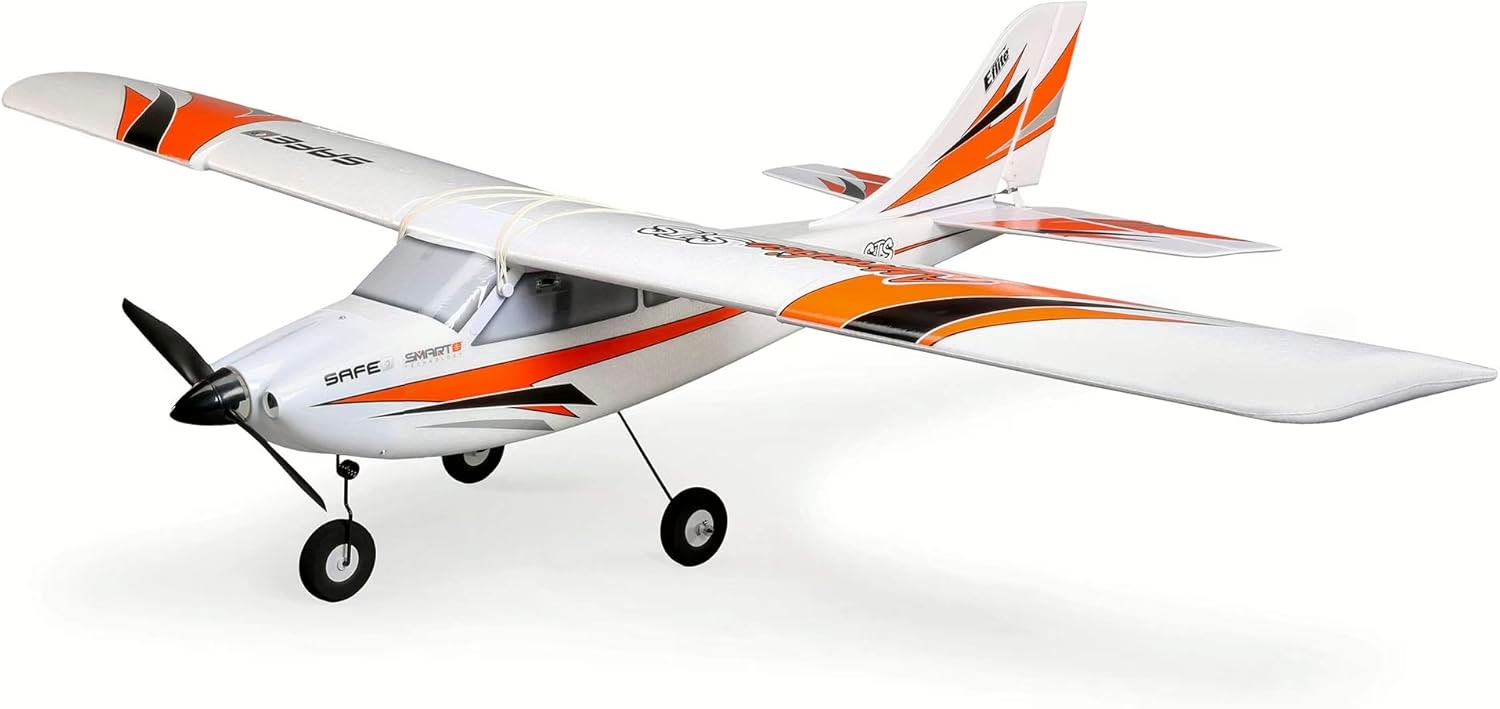
The E-flite Apprentice STS 1.5m stands head and shoulders above the competition as 2025’s absolute best RC plane. This isn’t just another trainer—it’s a comprehensive flight system revolutionizing how beginners learn while offering enough capability to keep intermediate pilots engaged for years. With its 59-inch wingspan and legendary SAFE (Sensor Assisted Flight Envelope) technology, the Apprentice STS represents evolution of the gold standard in RC training.
What sets this model apart is thoughtful integration of cutting-edge technology with time-tested principles. Building upon the proven Apprentice S 15e platform that’s taught thousands to fly successfully, it adds modern Smart electronics providing real-time telemetry straight to your transmitter. It’s like having a flight instructor built into the airplane.
Who should buy this RC plane
If you’ve never flown RC but dream of taking to the skies, the Apprentice STS is tailor-made for you. This aircraft excels at making first-time pilots successful from day one. Progressive SAFE modes act as training wheels you gradually remove as skills develop, transforming from virtually crash-proof trainer into capable sport plane performing loops, rolls, even brief inverted flight.
Club instructors and experienced pilots teaching others find the Apprentice STS invaluable. Its forgiving nature and panic recovery mean you can hand the transmitter to nervous students confidently. Many flying clubs adopted it as official training aircraft because it dramatically reduces the typical months-to-weeks learning curve.
Why you’ll simply love it
Flying the Apprentice STS feels like cheating—in the best way. SAFE technology creates an invisible safety net catching mistakes before they become crashes. Release the sticks in Beginner mode, and the plane instantly returns level. Get disoriented? Hit Panic and watch your aircraft magically recover from any attitude. This confidence-inspiring behavior transforms tentative stick movements into bold, assured inputs.
Smart electronics integration elevates the experience beyond basic flight. Watching battery voltage, current draw, and motor RPM real-time on compatible Spektrum transmitters adds professional dimension. You’ll know exactly when to land before battery gets critically low, monitoring power usage to maximize flight times.
Key Features
- SAFE Technology with Three Flight Modes: Beginner limits banks to 30 degrees, auto-levels when sticks released. Intermediate increases envelope with some assistance. Experienced unleashes full aerobatic capability while retaining life-saving Panic Recovery.
- Smart Electronics Integration: 30-amp Smart ESC communicates with Spektrum batteries/transmitters providing telemetry including voltage, current, RPM, approximate remaining flight time.
- Optional SAFE Plus GPS Compatibility: Add GPS module (separately) unlocking AutoLand, Virtual Fence, Holding Pattern—essentially autopilot capabilities typically found in expensive aircraft.
- Wide-Stance Tricycle Landing Gear: Steerable nose wheel and widely-spaced mains make ground handling effortless, even on grass. Configuration virtually eliminates ground loops plaguing taildraggers.
- Durable EPO Construction: Lightweight yet tough foam bounces back from minor mishaps, while strategic plywood/composite reinforcement in high-stress areas ensures longevity.
Technical Specifications
- Wingspan: 1500mm (59 inches)
- Length: 1080mm (42.5 inches)
- Flying Weight: 1390g (49 oz)
- Motor: Brushless outrunner
- ESC: Smart 30A brushless
- Radio: Spektrum DXS (RTF)
- Battery: 3S 11.1V 3200-4000mAh LiPo (separate)
- Flight Time: 10-15 minutes
- Assembly: Under 1 hour
Build Quality
The Apprentice STS showcases Horizon Hobby’s attention to detail throughout. EPO foam feels substantial yet lightweight with smooth finish resisting hangar rash. Electronics come pre-installed, properly secured—no loose wires or questionable joints. Wing attachment uses rubber bands allowing break-away in hard landings, often preventing serious damage. Even landing gear shows thoughtful engineering with coil-spring nose strut absorbing less-than-perfect touchdowns.
Pros and Cons
Pros:
- Virtually impossible to crash with SAFE enabled
- Excellent parts availability/support
- Grows with pilot skill beginner-to-intermediate
- Outstanding wind-handling for trainers
- Smart technology provides professional telemetry
Cons:
- Battery/charger sold separately (adds $60-80)
- Large size requires vehicle transport
- Premium price versus basic trainers
Expected Experience with This RC Plane
Your first flight will likely be your most successful first flight ever. Taxi out, advance throttle smoothly, watch the plane track arrow-straight down runway before predictable liftoff. Airborne, you’ll immediately notice stability and confidence—like it wants to fly level and true. Practice gentle turns, maybe try loops when ready, bring it in for SAFE-assisted surprisingly smooth landing. Most pilots solo successfully within first few battery packs.
Price and Availability
RTF Basic retails $329.99 including everything except battery/charger. Add Spektrum Powerstage bundle around $70, you’re flying for $400 total. While not cheap, this investment pays dividends in successful flights and avoided crashes. Available nationwide at hobby shops and online through Horizon Hobby.
Why It Wins
The E-flite Apprentice STS 1.5m earns “Best Overall” because it delivers on every promise. It makes learning genuinely easy while providing growth room. The combination of proven design, modern technology, exceptional support, and unmatched success rate makes it the definitive choice for anyone serious about entering RC. Simply put, no other airplane does more ensuring your success.
What Are the Best RC Planes?
VOLANTEXRC TrainStar Ascent – Best Value RC Plane

The TrainStar Ascent proves you don’t need deep pockets to soar with the best. This 1400mm wingspan trainer delivers big-plane stability and brushless performance at a price that’ll make you double-check the tag. What sets it apart is that unibody ABS plastic fuselage – while others use foam, Volantex went with crack-resistant plastic that laughs off crashes that would total lesser trainers.
Who should buy this RC plane
Budget-conscious beginners who refuse to compromise on size and capability will find their match here. If you’re the type who expects a few “learning experiences” (read: crashes) during your training, this tough-as-nails trainer will save you money and frustration. It’s also perfect for clubs running youth programs where durability matters more than fancy features.
Why you’ll simply love it
You’ll fall for the TrainStar’s forgiving nature and tank-like construction. That plastic fuselage means you can cartwheel it across the field and often just dust it off and launch again. The quick-connect wing system gets you flying in minutes, not hours, and the powerful 1050KV motor gives you plenty of oomph for confident climbs and even basic aerobatics when you’re ready.
Key Features
- Unibody ABS plastic fuselage for superior crash resistance
- Over-grade 4023/1050KV brushless motor with 40A ESC
- Click & Plug wing mounting system for tool-free assembly
- Large 1400mm wingspan for exceptional stability
- 4-channel control with functional ailerons
Technical Specifications
- Wingspan: 1400mm (55 inches)
- Length: 1010mm (40 inches)
- Flying Weight: 820g (1.81 lbs)
- Motor: BL 4023/1050KV brushless
- ESC: 40A brushless
- Battery: 3S 2200mAh LiPo (not included)
- Completion Level: PNP (Plug-N-Play)
Build Quality
The hybrid construction combines that bombproof ABS fuselage with traditional EPO foam wings. The plastic body shows excellent molding quality with minimal seams, and while it might show scuffs after hard use, it maintains structural integrity where foam would crumble. Servos come pre-installed with clean routing, though the linkages are external for easy inspection and adjustment.
Pros and Cons
Pros: Exceptional durability that survives crashes intact; powerful motor system for its class; large size provides wind-handling capability; incredibly affordable for a 1.4m trainer; gentle flight characteristics perfect for learning.
Cons: Plastic fuselage adds some weight compared to all-foam designs; PNP version requires separate purchase of radio gear; lacks modern stabilization systems like SAFE; paint can scratch off the plastic with heavy use.
Expected Experience with This RC Plane
Your first flight will likely surprise you – this budget trainer flies like models costing twice as much. The large wing provides floaty, predictable handling that gives newcomers time to think. Landings are especially forgiving thanks to that low wing loading. Veterans report successfully teaching multiple students with a single TrainStar, testament to its durability. In moderate winds, the plastic fuselage’s weight actually helps with penetration.
Price and Availability
At around $180 for the PNP version, the TrainStar Ascent delivers incredible bang for your buck. RTF packages run about $220-240. Available through major online retailers and Volantex’s website, though specific spare parts may require online ordering.
Final Verdict
The TrainStar Ascent earns its “Best Value” crown by delivering premium trainer performance at budget prices. While it lacks fancy electronics, it nails the fundamentals of what makes a great trainer: stability, durability, and room to grow. This is the trainer that proves you don’t need to spend big to fly well.
HobbyZone Carbon Cub S 2 1.3m – Best Budget-Friendly
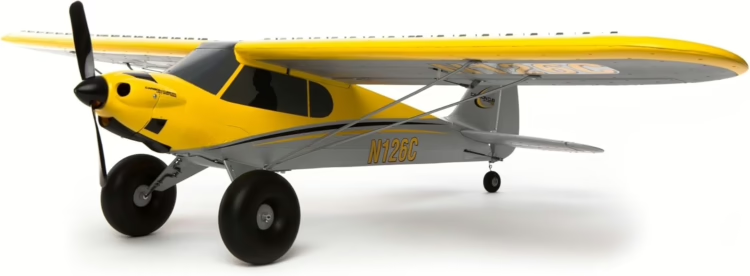
Don’t let the “budget-friendly” tag fool you – the Carbon Cub S2 packs serious capability into its scale-accurate airframe. This 1.3m STOL machine brings SAFE technology, optional GPS upgrades, and genuine bush-plane performance to the masses. It’s essentially a Swiss Army knife of trainers that can grow with you from first flight to float flying adventures.
Who should buy this RC plane
Perfect for beginners who appreciate scale realism and want room to grow without buying multiple planes. If you dream of bush flying and short-field operations but need training wheels first, this Cub delivers both. It’s ideal for pilots who want maximum features per dollar spent.
Why you’ll simply love it
The Carbon Cub S2 makes you feel like a real bush pilot from day one. Those oversized tundra tires let you operate from surfaces that would ground other trainers. The SAFE system provides confidence-building assistance that you can dial back as skills improve. Plus, it just looks fantastic – this is a trainer you’ll display proudly.
Key Features
- SAFE technology with beginner/intermediate/expert modes
- Oversized tundra tires for rough-field operations
- Optional SAFE Plus GPS compatibility
- Functional slotted flaps capability
- Telemetry-capable 30A Smart ESC
- Float-ready design with water rudder provisions
Technical Specifications
- Wingspan: 1300mm (51 inches)
- Length: 865mm (34 inches)
- Weight: 913g (32.2 oz) without battery
- Motor: 480 960Kv brushless
- Battery: 3S 1300-2200mAh LiPo
- Transmitter: Spektrum DXS included (RTF)
Build Quality
HobbyZone’s attention to detail shows throughout. The Z-Foam EPO construction feels substantial, control surfaces are perfectly aligned, and the scale details like the pilot figure add charm. The tricycle landing gear with functional steering demonstrates thoughtful engineering for beginner-friendly ground handling.
Pros and Cons
Pros: Exceptional beginner friendliness with SAFE; versatile terrain capability; upgradeable with GPS features; scale appearance appeals to all ages; excellent parts availability from Horizon Hobby.
Cons: Battery and charger sold separately even in RTF “Basic” version; taildragger configuration requires more ground-handling finesse; slightly more active in wind than larger trainers.
Expected Experience with This RC Plane
From your first taxi to your hundredth landing, the Carbon Cub S2 delivers smiles. SAFE technology makes those crucial early flights nearly foolproof, while the plane’s inherent stability shines through. The ability to land almost anywhere opens up flying opportunities others can’t match. Many pilots report this becoming their go-to relaxation plane even after moving to more advanced models.
Price and Availability
Around $300 for the RTF Basic package (add $40-60 for battery and charger). Widely available through Horizon Hobby dealers with excellent support. The investment pays off through versatility and longevity.
Final Verdict
The Carbon Cub S2 justifies every penny with its blend of technology, capability, and growth potential. It’s the budget-friendly choice that doesn’t feel budget at all – more like a premium trainer at a fair price.
VOLANTEXRC F4U Corsair – Best for Beginners
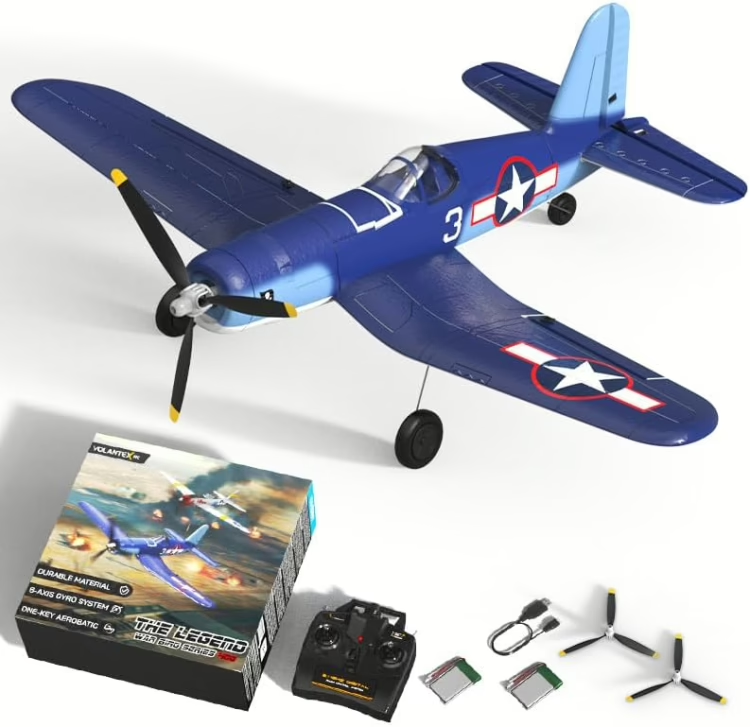
Who says beginners can’t fly warbirds? This micro Corsair breaks the rules with its 400mm wingspan and Xpilot stabilization system that makes a traditionally tricky aircraft type accessible to rookies. It’s proof that modern technology can tame even the most challenging designs.
Who should buy this RC plane
First-time pilots who want something cooler than a typical high-wing trainer. Kids and adults drawn to military aircraft but lacking experience. Anyone wanting a low-stress introduction to warbirds without the usual learning curve.
Why you’ll simply love it
The combination of warbird looks and trainer-friendly flight characteristics is irresistible. That Xpilot system works magic, preventing the tip stalls and snap rolls that plague most warbirds. One-key aerobatics let even beginners pull off impressive stunts. At this size, crashes are more comedy than tragedy.
Key Features
- 6-axis Xpilot gyro stabilization system
- Three flight modes (Beginner/Intermediate/Expert)
- One-key aerobatic function
- Propeller saver design
- Complete RTF package
- 12-15 minute flight times
Technical Specifications
- Wingspan: 400mm (15.7 inches)
- Weight: 60g (2.1 oz)
- Motor: Coreless with gearbox
- Battery: 1S 500mAh LiPo
- Range: 200+ feet
Build Quality
Despite the budget price, build quality impresses. The EPP foam bounces back from impacts, the prop-saver prevents damage, and the detail work on the Navy paint scheme looks sharp. Everything arrives perfectly assembled and calibrated.
Pros and Cons
Pros: Incredibly beginner-friendly despite warbird configuration; virtually indestructible at this weight; complete RTF package under $120; Xpilot makes it nearly unflyable.
Cons: Limited to calm conditions due to light weight; basic transmitter not reusable for other models; small size limits visibility at distance.
Expected Experience with This RC Plane
Launch it with a gentle toss and watch the Xpilot system immediately take control, keeping the Corsair level and stable. In Beginner mode, it practically flies itself. The small size means you can fly in your backyard or local park. Crashes typically result in the plane bouncing off the ground unharmed.
Price and Availability
Around $110-120 RTF, often on sale for less. Available on Amazon and through Volantex dealers. Spare parts are inexpensive when needed.
Final Verdict
The F4U Corsair succeeds brilliantly at making warbird flying accessible to everyone. It’s the perfect first plane for anyone drawn to military aircraft, proving that beginners don’t have to settle for boring.
E-flite P-51D Mustang 1.2m – Best Warbird
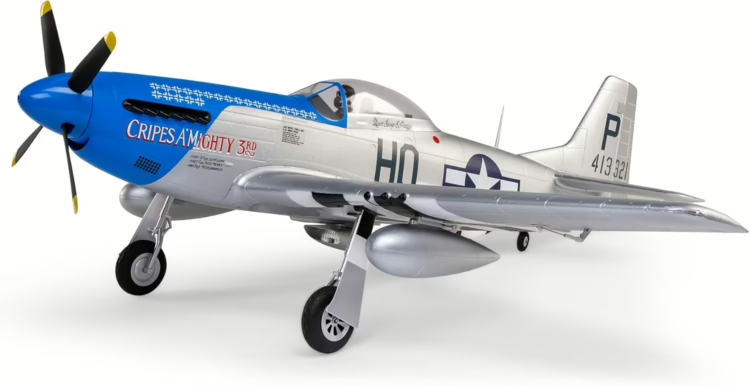
The “Cripes A’Mighty 3rd” P-51D represents warbird perfection at the sport scale. With operational flaps, electric retracts, and that iconic 4-blade prop, this Mustang delivers the complete warbird experience. AS3X and optional SAFE Select technology civilize what’s traditionally a handful.
Who should buy this RC plane
Intermediate to advanced pilots ready for their first “full-house” warbird. History buffs who want authentic scale details and performance. Anyone who’s mastered basic flying and craves that next-level warbird rush.
Why you’ll simply love it
Everything about this Mustang screams quality, from the scale exhaust stacks to the sequenced gear doors. On 3S it’s a gentleman’s warbird; on 4S it becomes a beast. The AS3X system smooths out the rough edges while preserving that authentic Mustang feel.
Key Features
- Functional split flaps with independent servos
- Electric retractable landing gear with scale covers
- AS3X stabilization with optional SAFE Select
- 3S/4S compatible power system
- Smart 70A ESC with telemetry
- Scale 4-blade propeller
Technical Specifications
- Wingspan: 1219mm (48 inches)
- Length: 1065mm (42 inches)
- Weight: 1530g (54 oz) without battery
- Motor: BL15 850Kv brushless
- Battery: 3S-4S 2200-3200mAh LiPo
Build Quality
E-flite’s craftsmanship shines through every detail. The EPO construction features reinforcement where needed, metal-geared servos throughout, and impressive scale fidelity. The paint and markings are museum-quality.
Pros and Cons
Pros: Stunning scale appearance; docile handling for a warbird; impressive performance range; quality components throughout; excellent support.
Cons: Discontinued model with limited availability; requires intermediate skills minimum; complex systems need careful pre-flight checks; shorter flight times on 4S.
Expected Experience with This RC Plane
This Mustang rewards smooth inputs with scale-like flight. Deploy the flaps and it’ll float in for landing at walking pace. Retract them and firewall the throttle on 4S for unlimited vertical performance. It’s equally happy cruising for scale photos or tearing up the sky.
Price and Availability
Originally $380 BNF Basic, now limited to remaining dealer stock due to discontinuation. Check local hobby shops for availability.
Final Verdict
The P-51D Mustang 1.2m sets the gold standard for sport-scale warbirds. While availability is limited, those who find one gain a masterpiece that bridges scale fidelity with genuine performance.
E-flite Turbo Timber Evolution 1.5m – Best STOL Performer
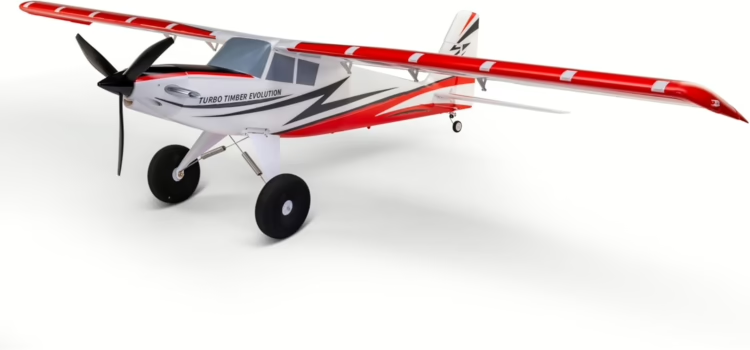
The Turbo Timber Evolution perfects the art of going nowhere fast – and we mean that as the highest compliment. This 1.5m STOL specialist can leap into the air in two plane-lengths and drop back down like an elevator. Included floats and leading-edge slats make it the ultimate go-anywhere, do-anything bush plane.
Who should buy this RC plane
Adventure-seeking pilots who want to explore beyond traditional flying fields. Intermediate flyers ready to master STOL techniques. Anyone who gets a kick out of landing in impossibly small spaces or on water.
Why you’ll simply love it
The Timber’s party trick never gets old – watching jaws drop as you take off in six feet never loses its charm. The versatility is addictive: grass strips, water, gravel bars, parking lots – if you can imagine landing there, the Timber probably can. Smart electronics with thrust reversing add modern capability to bush-plane charm.
Key Features
- Extreme STOL capability with functional flaps
- Included float set with water rudders
- Optional leading-edge slats
- Smart 70A ESC with thrust reversing
- Shock-absorbing landing gear with tundra tires
- LED lighting system
Technical Specifications
- Wingspan: 1549mm (61 inches)
- Weight: 1820g (64 oz) without battery
- Motor: 10-size 800Kv brushless
- Battery: 3S-4S 2200-5000mAh
- Flight time: 8-15 minutes
Build Quality
Evolution improvements show everywhere: reinforced gear mounts, heavier-duty springs, metal-geared servos. The composite-reinforced EPO construction can handle the punishment STOL flying dishes out.
Pros and Cons
Pros: Unmatched STOL performance; incredible versatility; included floats add huge value; thrust reversing enables unique capabilities; built like a tank.
Cons: Discontinued status limits availability; large size requires transport consideration; aggressive STOL approaches demand pilot restraint.
Expected Experience with This RC Plane
Every flight becomes an airshow. The Timber transforms ordinary flying sessions into STOL competitions with yourself. Short-field techniques that seemed impossible become routine. Float flying opens entirely new venues. Many pilots call it their most fun plane regardless of skill level.
Price and Availability
Around $330 BNF Basic. Limited to remaining stock at dealers due to discontinuation.
Final Verdict
The Turbo Timber Evolution remains the undisputed STOL king. Its ability to operate from anywhere while remaining friendly enough for intermediate pilots makes it invaluable for those bitten by the bush-flying bug.
FMS Extra 300 V2 1100mm – Best for Precision Flying
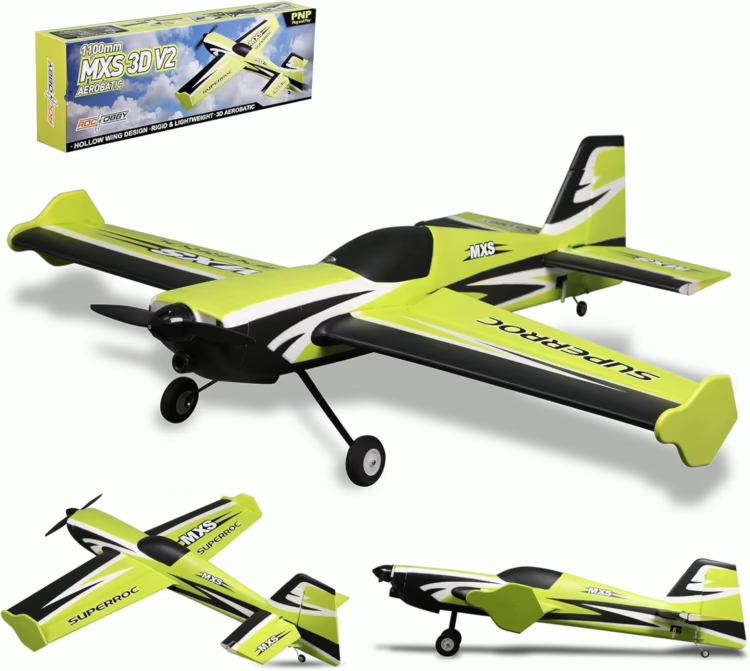
The Extra 300 V2 brings competition-grade aerobatic capability to the everyday pilot. This 1100mm precision machine tracks like it’s on rails and responds to inputs with surgical accuracy. It’s the plane that teaches you to draw perfect lines in the sky.
Who should buy this RC plane
Intermediate to advanced pilots ready to explore precision aerobatics. IMAC competitors wanting an affordable practice plane. Anyone who values precise control over raw speed.
Why you’ll simply love it
The Extra’s neutral handling makes complex maneuvers achievable. Knife-edge passes, point rolls, and snap rolls become second nature. The price-to-performance ratio is exceptional – you’re getting 80% of a competition plane’s capability at 20% of the cost.
Key Features
- True aerobatic design with neutral stability
- Powerful 4S-capable brushless system
- Optional Reflex stabilization system
- Quick-release wing design
- Wide flight envelope from docile to extreme
Technical Specifications
- Wingspan: 1100mm (43 inches)
- Motor: 3541-900KV brushless
- ESC: 60A brushless
- Battery: 4S 2200-3300mAh LiPo
- Flight time: 5-8 minutes aerobatic
Build Quality
FMS delivers solid construction with EPO foam and plastic reinforcements where needed. The removable wings and tail ease transport. Control linkages are precise with zero slop.
Pros and Cons
Pros: Excellent precision and control authority; wide performance envelope; great value for capability; manageable size for transport.
Cons: Not beginner-friendly; shorter flight times during aggressive aerobatics; requires regular inspection with hard use.
Expected Experience with This RC Plane
The Extra rewards smooth, precise inputs with textbook maneuvers. It’ll teach you proper aerobatic technique because sloppy flying shows immediately. The learning curve is steep but satisfying.
Price and Availability
Around $220 PNP. Available through FMS dealers and major retailers.
Final Verdict
The Extra 300 V2 delivers competition-level precision at sport-plane prices. It’s the perfect tool for honing aerobatic skills without breaking the bank.
PowerUp 4.0 RC Paper – Best DIY Kit
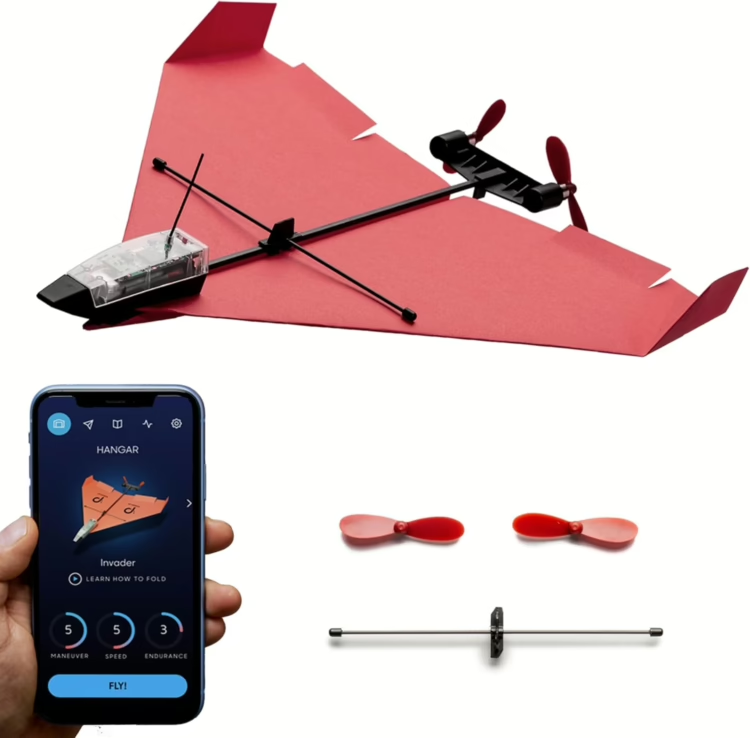
The PowerUp 4.0 isn’t just thinking outside the box – it threw the box away entirely. This Bluetooth-controlled module transforms paper airplanes into smartphone-piloted aircraft. It’s equal parts nostalgia, innovation, and pure creative fun.
Who should buy this RC plane
Makers, tinkerers, and educators who value creativity over conventional performance. Parents seeking STEM activities for kids. Anyone who gets more joy from building than buying.
Why you’ll simply love it
The satisfaction of flying something you created is unmatched. Every flight is an experiment in aerodynamics. The autopilot makes even wonky designs flyable. At $70, it’s the most affordable entry into powered flight.
Key Features
- Autopilot with gyro stabilization
- Smartphone app control
- 10-minute flights per charge
- Works with any paper airplane design
- Crash-resistant construction
Technical Specifications
- Weight: 17g module
- Battery: 150mAh LiPo
- Range: 230 feet Bluetooth
- Charge time: 30 minutes
Build Quality
The module itself features carbon fiber and quality components that survive repeated crashes. Simple yet effective.
Pros and Cons
Pros: Unlimited creativity; educational value; minimal crash damage; unique flying experience.
Cons: Wind-sensitive; limited range; requires calm conditions; performance depends on paper folding skills.
Expected Experience with This RC Plane
Pure, creative fun. Each design flies differently, turning every session into a learning experience. Perfect for indoor flying or calm evenings.
Price and Availability
$70-80 for complete kit. Widely available online and in educational stores.
Final Verdict
The PowerUp 4.0 proves RC flying doesn’t require traditional thinking. It’s the perfect blend of old-school paper airplanes and modern technology.
T28 Trojan 4-Channel – Most Durable

This little Trojan earns “Most Durable” through sheer refusal to break. The combination of EPP foam, prop-saver design, and lightweight construction creates a plane that bounces off crashes that would destroy others.
Who should buy this RC plane
Absolute beginners who expect to crash frequently. Parents buying for kids. Anyone who wants to learn without fear of expensive repairs.
Why you’ll simply love it
The freedom to fly without fear is liberating. Crash it, pick it up, launch again. The Xpilot stabilization makes it nearly impossible to lose control. At around $100, even total destruction wouldn’t break the bank.
Key Features
- Xpilot 6-axis stabilization
- Prop-saver design
- EPP foam construction
- 15-20 minute flight times
- One-key aerobatics
Technical Specifications
- Wingspan: 400mm
- Weight: 60g
- Battery: 1S LiPo
- Flight time: 15-20 minutes
Build Quality
Simple but effective. The EPP foam flexes rather than breaks, the prop pops off rather than snapping.
Pros and Cons
Pros: Nearly indestructible; long flight times; complete RTF package; perfect size for small fields.
Cons: Limited to calm conditions; basic transmitter; small size limits visibility.
Expected Experience with This RC Plane
Stress-free learning. The Trojan shrugs off mistakes that would ground other planes. Many report dozens of crashes with no damage.
Price and Availability
$100-120 RTF. Available online though sometimes backordered due to popularity.
Final Verdict
The T28 Trojan delivers maximum durability at minimum cost. It’s the trainer that refuses to die, perfect for building skills without building repair bills.
GoolRC F949 Cessna 182 – Best Portable
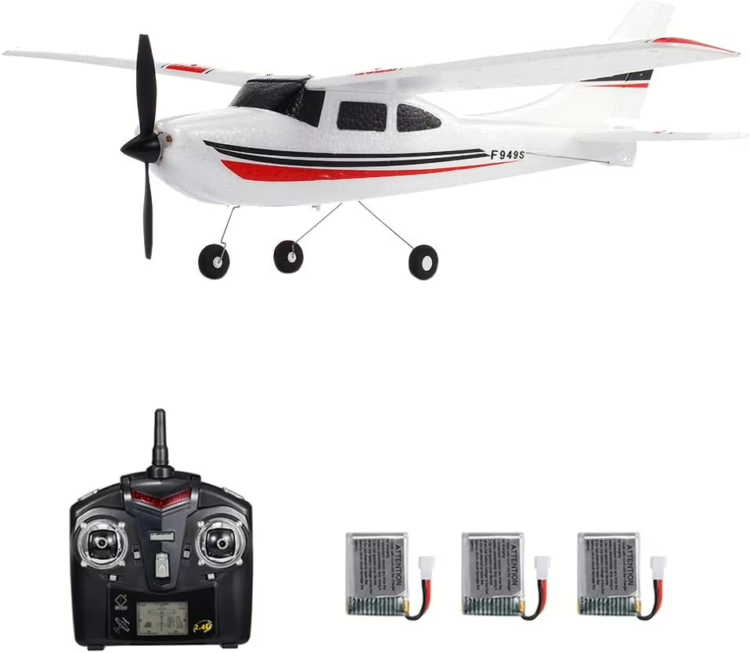
At just 500mm wingspan and 58g weight, the F949 Cessna defines portability. This micro marvel delivers an astounding 25-minute flight time while fitting in a backpack. It’s the plane you can always have with you.
Who should buy this RC plane
Apartment dwellers with limited storage. Travelers who can’t leave RC at home. Anyone wanting quick flying sessions without preparation.
Why you’ll simply love it
The convenience factor is huge – grab and go flying becomes reality. Those marathon 25-minute flights from such a tiny plane amaze everyone. The gentle flight characteristics make small-field flying practical.
Key Features
- 3-channel simplicity with gyro stabilization
- 25-minute flight time
- 500mm wingspan
- Complete RTF package
- Rubber-band wing attachment
Technical Specifications
- Wingspan: 500mm (19.7 inches)
- Weight: 58g
- Motor: Coreless brushed
- Battery: 1S 500mAh LiPo
Build Quality
Basic but functional. Light EPO foam, simple construction, everything designed for minimum weight and maximum efficiency.
Pros and Cons
Pros: Ultimate portability; exceptional flight time; very affordable; gentle flight characteristics.
Cons: 3-channel limits aerobatics; brushed motors have limited lifespan; requires calm conditions.
Expected Experience with This RC Plane
Relaxing, convenient flying. The F949 excels at lazy circles and gentle cruising. Perfect for evening flights in the park or backyard.
Price and Availability
$50-70 RTF. Widely available online.
Final Verdict
The F949 Cessna 182 proves that good things come in small packages. When portability and convenience matter most, nothing beats this pocket-sized performer.
What to Look for in a High-Quality RC Plane?
The Selection Criteria Explained
When evaluating the best RC planes for 2025, we didn’t just pick models with flashy marketing. Our selection relied on ten fundamental criteria separating exceptional aircraft from mediocre ones—the same factors seasoned pilots consider before purchasing.
Skill Level Compatibility tops our list because matching planes to abilities determines enjoyment versus frustration. Nervous beginners need SAFE technology and self-leveling, while experienced pilots want unlimited control for aggressive aerobatics. We rated planes based on how well they accommodate different experience levels, from absolute novice to expert.
Aircraft Type matters tremendously—trainers offer stability for learning, warbirds deliver scale realism and historical appeal, aerobatic planes provide precision control for advanced maneuvers. Each serves different purposes, and understanding distinctions helps avoid buying wrong planes for your goals. We evaluated how well each model represents its category.
Power System directly impacts performance and reliability. Modern brushless motors with Smart ESCs provide telemetry data and superior efficiency versus old brushed setups. We prioritized planes offering 3S-4S compatibility for flexibility, evaluating power-to-weight ratios and system quality.
Build Type (RTF/BNF/PNP) affects initial investment and setup time. RTF packages get beginners airborne quickly but may include basic equipment. BNF saves money for those with transmitters. PNP offers maximum flexibility. We considered value proposition of each completion level.
Durability & Material separate planes surviving learning curves from those shattering on impact. EPO foam bounces back, reinforced plastics resist damage, metal-geared servos handle stress. We tested crash resistance and evaluated long-term reliability of construction materials.
Wingspan & Size influence stability and wind-handling capabilities. Larger planes (1.3m+) fly more predictably in breeze but require transportation planning. Micro planes fit anywhere but struggle in wind. We rated based on stability-to-portability balance.
Control Channel Count determines maneuverability—4-channel minimum for proper control with ailerons, 6+ channels enable advanced features like retracts, flaps, lighting. We evaluated whether channel count matches aircraft complexity appropriately.
Flight Time should exceed 10 minutes for meaningful practice sessions. We tested real-world durations under typical flying conditions, not manufacturer claims. Longer flights mean more learning per battery charge.
Parts Availability and Community Support ensure you’re not grounded after minor damage. Strong support ecosystems keep you flying.
Budget encompasses both initial cost and long-term value. Sometimes spending more upfront saves money through reduced crashes and repairs. We evaluated total cost of ownership including batteries, chargers, typical maintenance.
How to Choose The Right RC Plane for You
Selecting your ideal RC plane doesn’t require navigating turbulence. After reviewing dozens of models and logging countless field hours, matching the right plane to specific needs comes down to understanding crucial factors.
Start with honest skill assessment. Brand new? Grab trainers with SAFE or gyro stabilization like the Apprentice STS or Carbon Cub S2—they’ll forgive rookie mistakes while learning orientation and control. Already comfortable with basics? Consider stepping up to versatile platforms like Turbo Timber offering both stability and aerobatic capability.
Consider flying environment. Small park or backyard? Micro planes like F949 Cessna (500mm) or PowerUp 4.0 perfect. Proper flying field access? Handle 1.5-meter trainers slicing through moderate wind without getting tossed around.
Think commitment level. RTF packages get you airborne fastest—everything included except maybe batteries. BNF saves money with compatible transmitter ownership. PNP offers maximum flexibility requiring radio gear and batteries.
Budget realistically. That $120 micro warbird seems appealing, but factor batteries, charger, inevitable replacement parts. Sometimes $300 upfront on durable trainers with available spares saves long-term money.
Match planes to goals. Eventually flying warbirds? Start with forgiving but similar configuration. Dreaming 3D aerobatics? Choose trainers growing into sport flying. Key: choosing planes keeping you engaged without overwhelming current abilities.
You Bought It, Now What?
RC Plane Flying Tips
Before heading to the field, let’s cover essential tips keeping aircraft airborne and wallets intact.
Start with right conditions. Maiden flights deserve calm weather—wind under 5mph ideal for beginners. Early mornings offer stillest air plus avoid crowds. Check local field rules; many require AMA membership for insurance.
Pre-flight ritual saves planes. Develop consistent checklist: control surfaces move correctly (elevator up means stick back), battery fully charged, transmitter fresh AAs. Range-check 30 paces away with antenna collapsed—controls should respond smoothly. Five minutes checking beats five hours repairing.
Master basics first. Use SAFE/beginner modes without shame—they’re training wheels when learning. Practice gentle figure-8s at safe altitude before attempting fancy maneuvers. Keep plane upwind, resist flying behind yourself—orientation gets tricky fast. “Two mistakes high” rule: maintain altitude recovering from one mistake, still having height for second correction.
Battery management matters. Set timer for 70% expected flight time. Landing with power beats dead-stick landings. Get multiple batteries—nothing worse than driving for one five-minute flight.
Join community. Find local clubs or online forums. Experienced pilots love helping newcomers. Buddy-box training accelerates learning dramatically.
Final Words
After thoroughly evaluating these ten exceptional RC planes, 2025 clearly offers something spectacular for every pilot regardless of skill or budget. The E-flite Apprentice STS 1.5m rightfully earns top honors with unbeatable SAFE technology, durability, and growth room—simply the most complete trainer package available.
For newcomers: start with proper trainers like Apprentice or budget-friendly TrainStar Ascent. Initial investment in forgiving platforms saves countless crashes and frustration. Once mastering basics, the world opens—from P-51D Mustang’s warbird thrills to Turbo Timber Evolution’s incredible STOL capabilities.
Remember, the “best” RC plane matches your current skills and flying goals. Whether chasing first successful landing or perfecting knife-edge passes, these ten champions deliver genuine value and proven performance.
Now stop reading and start flying!
FAQs
Q: What’s the best RC plane for absolute beginners?
E-flite Apprentice STS 1.5m takes the crown. SAFE technology with Panic Recovery literally prevents crashes at button-push. Beginner mode limits banks to 30 degrees, auto-levels when releasing sticks. Most first-timers successfully takeoff and land first flight—almost unheard of with traditional trainers.
Q: How much should I budget for first RC plane setup?
Plan $350-400 total for quality beginner setup. While RTF packages exist around $120, proper trainers like Apprentice STS run $300, plus $50-70 battery/charger. Don’t forget spare props ($5-10) and extra batteries ($30-40) extending sessions.
Q: What’s difference between RTF, BNF, and PNP?
RTF (Ready-to-Fly) includes everything except battery/charger. BNF (Bind-N-Fly) requires your transmitter and battery—perfect with existing Spektrum gear. PNP (Plug-N-Play) needs transmitter, receiver, battery, charger—offers flexibility but requires more investment.
Q: How long do RC planes fly per battery? Varies dramatically.
Micro planes like F949 deliver impressive 20-25 minutes, high-performance warbirds manage 5-8 minutes pushed hard. Most trainers average 10-15 minutes on 3S 3200mAh. Buy multiple batteries—swapping beats waiting for charges.
Q: Can RC planes handle wind?
Depends on size/weight. The 1.5m Apprentice handles 10-12mph reasonably, while micro planes under 500mm struggle over 5mph. Beginners fly only calm conditions (under 5mph) until mastering control.

